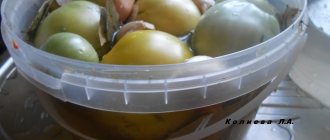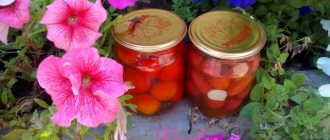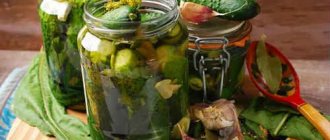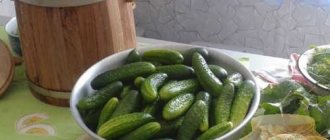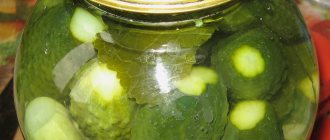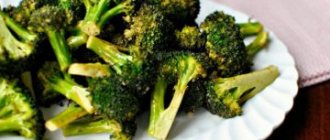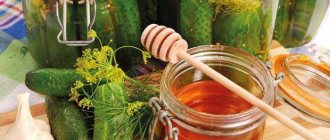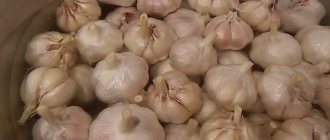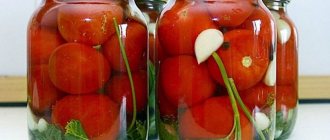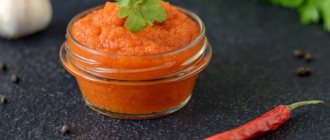Is it possible to pickle cucumbers in a plastic bucket?
Many housewives advise using special containers for preparing winter pickles. The most suitable are enameled iron buckets, in which the pickles are very tasty and aromatic. However, sometimes people do not have the opportunity to use such utensils and have to salt in a plastic bucket.
Some people believe that containers made of plastic negatively affect the taste of pickles, but this is not the case.
Vegetables pickled in a plastic bucket are no different from pickles prepared in enamel buckets.
How to properly store pickles
You can store the product directly in the bucket in which fermentation occurs, but only on condition that the container is located in a cool and dark place (cellar, basement, refrigerator). If this is not possible, it is best to put crispy vegetables in jars and roll them up.
This can be done only after the fermentation process is completed, which depends on the type of pickling: cold-salted greens ferment for 30–45 days, hot-salted greens for 7–10 days. The olive color of the peel will indicate the vegetables are ready.
Rolling up salted greens consists of the following points:
- Drain the brine and strain it through a sieve or cheesecloth (three times).
- Rinsing greens and herbs under clean running water to remove white deposits.
- Washing jars in water and soda.
- Putting washed herbs and spices into jars (it is also recommended to transfer and cover vegetables on top).
- Putting cucumbers in a jar.
- Boil the brine and pour pickles over it for 20 minutes. Then the brine is drained and boiled a second time. The procedure is repeated again after 15 minutes. During the boiling process, a white foam will form on the brine; it must be collected using a slotted spoon.
- The greens drenched in brine are rolled up with sterile lids, wrapped and left to cool completely.
Principles of pickling cucumbers in a bucket
Before you start pickling vegetables in an enamel or plastic bucket, you need to familiarize yourself with the basic recommendations for performing such work:
- You need to use fresh cucumbers, without signs of rotting;
- before preparing pickling, you must carefully inspect the container and make sure that it is intact;
- It is necessary to pickle the cucumber preparation for at least two days;
- Fermentation of pickles should be carried out in a dark and cool room, where temperatures do not rise above 10-12 degrees.
How to store
Cucumbers retain their benefits and taste at temperatures from 0° to +1°C and humidity not exceeding 90% . The ideal place for storage is a dry cellar or basement. Storage near a battery or other heat sources, in frost or open sun is not allowed. For storage at home, a pantry or dark kitchen cabinet is suitable. Before use, cool the cucumbers in the refrigerator for two hours.
The storage period depends on the recipe. The average period is 6–8 months. If the brine becomes cloudy and sour, it means the snack has spoiled and should not be consumed.
Important! It is not recommended to transfer cucumbers from a bucket to another container - this will quickly spoil them.
Preparation of ingredients and containers
Particular attention should be paid to the choice of containers and ingredients. It is recommended to select high-quality and ripe cucumbers. They should not be too big or overripe. Juicy cucumber fruits without cavities inside are suitable for pickling. There should be no large pimples or black spikes on the surface of the peel.
When choosing a suitable bucket, pay attention to its integrity. Therefore, carefully inspect the bottom and walls of the container in advance to make sure there are no cracks. It is better to give preference to enameled products, but plastic ones are also suitable.
See also
Simple recipes for pickling porcini mushrooms for the winter at homeRead
Lightly salted cucumbers
Sometimes you want delicious sour cucumbers, but you don’t have time to wait. These recipes for quick lightly salted cucumbers will help you with this. You can, of course, make them according to the recipe described above, I will not repeat it. But it takes a long time, but it could be faster.
Quick lightly salted cucumbers with mineral water
The ingredients are almost the same as for the winter, only with this recipe they will be ready the next day.
Ingredients:
- 1 kg. young cucumbers
- 1 liter of mineral water
- 2 tbsp. small heaped tablespoons of salt
- 3-4 cloves of garlic
- dill umbrellas or a bunch of green dill
Preparation:
1. Let's start cooking as always by preparing the ingredients. Let's wash the dill, peel and cut the garlic into slices, wash the cucumbers (don't forget about soaking) and cut off their asses. For even quicker pickling, prick the cucumbers with a fork so that the brine penetrates under the skin faster, but this is only if you are in a hurry to try lightly salted cucumbers.
2. Place garlic and dill in a clean jar, with cucumbers on top.
3. Dissolve the salt in mineral water. To do this, we poured the water into a jar, but you can also pour it into a bottle. Pour water into a jar and leave at room temperature for one day.
4. After a day, put the cucumbers in the refrigerator. But they are the most delicious and lightly salted on the first day. Therefore, we usually guess when guests arrive, or when they want to eat delicious cucumbers.
You can see how we made them for the first time here.
Methods for pickling cucumbers in a bucket for the winter
There are several common ways to pickle cucumbers for the winter.
A simple recipe for lightly salted cucumbers
People who have not pickled vegetables before should use a simple recipe. To prepare crispy and tasty cucumbers, you need the following ingredients:
- eight kilograms of cucumber fruits;
- five dill umbrellas;
- 10 liters of water;
- leaves of horseradish, cherry and laurel;
- three heads of garlic.
Vegetables are washed, placed in a bucket and soaked for 10-12 hours. Then spices and cucumbers soaked in water are added to the pickling container. To make salted vegetables tasty, the container is filled with brine. Salting lasts about a week.
Cold way with vodka
To prevent pickled cucumbers from spoiling longer, they must be pickled with vodka. To prepare this snack you will need the following products:
- 5-6 kilograms of medium-sized cucumbers;
- 80 milliliters of vinegar;
- 150 grams of salt;
- 180 milliliters of vodka;
- 7-8 liters of water.
Vegetables are soaked in a basin filled with water. Then they are poured into buckets for further salting. The brine that will be poured into the container with the ingredients is prepared in advance. To do this, boil water and mix it with salt and spices to taste. Then pour the cooled brine liquid over the vegetables and add vodka. The fermentation process lasts one and a half weeks.
Without vinegar
Sometimes housewives decide to salt winter preparations without adding vinegar. The preparation is made from the following ingredients:
- 4-5 kilograms of cucumbers;
- 100 grams of salt;
- spices;
- currant leaves.
First, cold water is poured into a bucket and spices and salt are added to it. After 2-4 hours, washed vegetables are added to the container, after which the bucket is transferred to a dark basement for 1-2 weeks.
Option with garlic
Pickles with spicy garlic are more tasty and aromatic. Therefore, many housewives add this ingredient to them. This appetizer is quite simple to prepare. To make pickling for fermentation, add 150-200 grams of sugar with three chopped heads of garlic to ten liters of water. The liquid is infused for at least five hours, after which cucumbers are placed in it.
With bell pepper
Preparing a pickled vegetable dish with bell peppers begins with preparing the vegetables. First, they are washed and placed in an empty bucket. Then a brine is made in a separate container, consisting of 8-9 liters of water, 5-6 bay leaves, allspice and parsley. Add some salt to the brine mixture and pour it over the cucumbers. They should ferment for 3-4 days at a temperature of 15-20 degrees.
See also
11 best ways to pickle cucumbers to make them crispyRead
With hot pepper
To make the pickle spicier, add 5-7 pods of hot pepper. Cucumber fruits along with pepper are washed and poured into buckets for pickling. Then, a brine is prepared from 250 grams of salt and ten liters of water, which is poured into a container with vegetables. The salting will take about seven days.
Country cucumbers
To prepare country-style pickles, you need:
- Place five laurel leaves, a horseradish root, currant and cherry leaves on the bottom of a bucket or wooden barrel;
- add cucumbers and garlic to the spices, then mix everything thoroughly;
- pour salted water over everything and leave to ferment in the room for ten days.
Like cask
To get delicious cucumbers that will resemble barrel pickles, you need to:
- put currant, laurel, horseradish and cherry leaves on the bottom of the container;
- peel and chop four heads of garlic and put it along with the spices;
- soak the cucumber fruits and place them tightly in a bucket;
- Fill the laid out ingredients with water, add 200 grams of salt, cover everything with a lid and leave in the room for 10-12 days.
Cucumbers fermented with bread
First, cut up pieces of black or white bread are placed at the bottom of the bucket in which the vegetables will be salted. Laurel leaves, allspice, horseradish and other spices are placed on top to add flavor. Then the container is filled with soaked cucumbers, after which cold brine is poured. The mixture should ferment for 5-8 days.
Pickles for the winter in a plastic bucket. Pickled cucumbers in an enamel bucket
Greetings, dear readers of the blog Ode to Cooking!
Pickled cucumbers – who doesn’t know this is a true Russian appetizer. In addition, pickled cucumbers are indispensable in preparing rich pickles, refreshing okroshkas and beetroot pancakes on a hot summer day, vinaigrettes, Olivier salad and other dishes of national Russian cuisine.
Many people would like to know the recipe for fermenting cucumbers in an ordinary enamel bucket. Find out how to ferment cucumbers in an enamel bucket from this recipe.
In a city apartment, you can also make pickled cucumbers. And the most suitable container for this procedure is an ordinary enamel bucket. And then the finished cucumbers can be rolled into three-liter jars for storage until winter. So, a very simple recipe for making pickled cucumbers in an enamel bucket.
Preparation:
Step 1. Sort the cucumbers, rinse thoroughly with cold water, remove the ends. Then pour clean cold water for 6-8 hours. During this time, the cucumbers will be saturated with water, become hard, and give off bitterness. Meanwhile, wash the enamel bucket. Peel the garlic. Rinse the herbs and spread them on a towel, let them dry a little.
Step 2. After 6-8 hours, rinse the cucumbers with cold water and transfer them to a clean enamel bucket, sprinkle with garlic and spices. Cucumbers should not reach 10 centimeters to the edge of the bucket. Place the remaining currant, cherry and horseradish leaves and dill umbrellas on top of the cucumbers.
Step 3. Place the bucket of cucumbers in a spacious basin.
Step 4. Prepare the brine. Pour 5-6 tablespoons of coarse salt into a three-liter jar and fill with clean cold water. Stir the salt mixture until the crystals are completely dissolved and pour into a bucket of cucumbers. The brine should completely cover the cucumbers. You may need 1.5-2 three-liter jars of saline solution.
Step 5. Cover the cucumbers with a plate with a load, for example, a jar of water. Cover the bucket with a clean cloth, maybe several folds of gauze, and put it in a dark, cool place for 3-5 days to ferment the product. After 3-5 days, pickled cucumbers are ready to eat.
If you want to preserve pickled cucumbers until winter in a city apartment, roll them up as follows. Remove the cucumbers from the bucket and rinse under running water. Spices and herbs can be thrown away; they have already given up their aroma and taste to the brine and cucumbers. Strain the brine, pour into a saucepan and boil, removing the foam with a slotted spoon.
Place cucumbers tightly in jars and pour boiling brine up to the neck. Cover the jars with lids and let stand for 10-15 minutes. Pour the brine back into the pan and boil again. Fill the cucumbers again to the very top and quickly roll up. Turn the jars over onto a lid, cover with a blanket and let cool completely.
Happy pickling and see you again!
View all blog posts here
Good morning everyone! The hot time for conservation has arrived. You need to have time to prepare countless jars of jams and pickles in order to delight yourself and your guests with pickles in winter. There are hot and cold salting methods.
Cold pickling of crispy cucumbers for the winter allows you to preserve more vitamins and get the taste of real pickled cucumbers without vinegar, which are suitable for salads, pickles, and hodgepodges much better than other types of pickled greens.
To make cucumbers crispy, you must follow a number of rules:
- It would be ideal to use your own, from the garden. But if this is not possible, then when purchasing, choose specimens with black spikes, pimples and small grains. They should be small in size;
- Pre-soak them in cold water so that they are saturated and do not absorb all the brine when salting;
- It is advisable to use coarse salt that is not iodized;
- Rinse the jars thoroughly with soda and scald with boiling water or heat in a microwave or oven;
- When choosing greens, I do not recommend using currant leaves, as mold may form;
- We take nylon lids. Metal ones may become rusty;
- I do not recommend using chlorinated water, preferably from a well or bottled;
- Store the finished jars in the refrigerator or cellar.
Recipes for pickling cucumbers for the winter
There are many pickling options, but all of them will definitely require ingredients such as;
- Water;
- Salt;
- Cucumbers;
- Spices.
I advise you to try several different recipes in order to ultimately choose your only, most favorite and delicious one.
Cold method of pickling cucumbers in jars for the winter
I usually use small jars for pickles - liter or even smaller. But when cold-salting, I still prefer three-liter jars.
We will need:
- Cucumbers - how many will fit into the jar;
- We calculate salt as follows - 2 tbsp. per liter of water;
- Dill umbrellas;
- Peeled garlic;
- Horseradish leaves;
- Cherry leaves;
- Black peppercorns.
How to cook?
- Dissolve salt in water. For convenience, you can heat a small amount of water and dissolve the crystals in it, and then dilute with cold water to the prescription amount;
- There may be some salt residue left at the bottom. I don't use it;
- Place horseradish leaves and dill on the bottom of a clean and dry jar;
- We lay the cucumbers along with horseradish and cherry leaves and dill umbrellas;
- Throw in black pepper;
- Fill with cold brine, cover with gauze and leave in a cool place for several days. This is my summer kitchen, it’s always cool there;
- Don't forget to place a plate or cup under the jar. During the fermentation process, water will pour out. This is fine. Make sure that it completely covers the cucumbers, and add salt brine if necessary (at the rate of 1 tablespoon of salt per half liter of water);
- The fermentation process may take several days. This is directly related to the temperature of the room in which your cucumbers ripen in a jar. If it is in a cold place, the process is delayed;
- The pickle may become cloudy and foamy. Don't be afraid - then it will lighten, the foam will disappear;
- When the fermentation process is over, cover the jar with a nylon lid and store it in the refrigerator or cellar.
Cold pickling of cucumbers with mustard
To obtain a more piquant taste of cucumbers, use mustard, hot pepper or bell pepper. We will cook it with dry mustard.
Required:
- Cucumbers;
- Salt 2 tbsp. spoons per liter of water;
- Bay leaf;
- 2 tbsp. spoons of dry mustard;
- Horseradish leaves;
- A few peas of black and allspice;
- A pair of dill umbrellas;
- 5 - 6 cloves of garlic.
Preparation:
- Pre-soak the cucumbers for a couple of hours;
- During this time, prepare the jars: rinse with soda, dry in the oven;
- Place horseradish leaves and garlic in the bottom of the container. Place the fruits mixed with pepper and dill on top. Cover with horseradish leaf;
- Prepare brine using cold water. You can use the option from the previous recipe;
- Pour into a jar, cover with gauze and place in a cool place for a couple of days. Don’t forget to place the container in a cup so that when the water flows out, it doesn’t get on the table;
- Then pour the mustard into a jar and leave it on the kitchen table for five to six hours;
- Drain the brine and boil for 5–7 minutes, pour it back into the jar, roll it up and cool it upside down under a blanket.
Cold pickling of cucumbers with vodka
Intrigued? How is it with vodka? It's very simple and very tasty. The main thing is that your husband does not drink the prepared vodka before you prepare everything for pickling. Go.
We will need:
- Cucumbers;
- Dill umbrellas;
- Horseradish leaves;
- A few cloves of garlic;
- 6 – 7 pieces of black peppercorns;
- 2 tbsp. l. vodka per liter of brine;
- Cherry leaves;
- Salt - 2 tbsp. level spoons per liter of water.
How to prepare cucumbers with vodka for the winter?
- We wash the cucumbers well, pour boiling water over them, and roll them in ice water;
- Soak in cold water for two to three hours;
- Place cucumbers mixed with garlic, cherry and horseradish leaves, and dill in a pre-prepared jar on a layer of greens;
- Let's prepare the brine - dissolve the salt in cold water, add vodka;
- Pour this over the cucumbers and cover with a nylon lid;
- We will immediately send it for storage in a cellar or refrigerator;
- You can taste it in a week. They store without problems, turn out crispy and very tasty.
Source: https://rootsbar.ru/conservation/pickled-cucumbers-for-the-winter-in-a-plastic-bucket-sour-cucumber-in-an-enameled-bucket/
How to pickle cucumbers for the winter without vinegar in a cold way: recipes, videos
The harvesting season is a hot time for any housewife. When harvest time begins and work is in full swing in the kitchen, I really want to do without unnecessary hot processes: boiling, sterilization and pasteurization. This is possible if you pickle cucumbers in a cold way.
Cold pickling of cucumbers is considered the simplest and most convenient way of home canning, allowing you to preserve the beneficial properties of vegetables
Cold salting technologies have come down to us since ancient times. Previously, capacious wooden barrels and tubs were traditionally used for it.
Now cucumbers can be pickled in a plastic bucket or in an enamel pan, ceramic or glass container.
Many people prefer to cold pickle cucumbers for the winter in jars of a suitable size (liter, three-liter), which are easier to store and more convenient to use.
It has long been customary in Rus' to salt cucumbers with cold water in oak barrels, which added additional flavor and provided an unsurpassed crunch.
All pickling recipe options are based on a minimum set of ingredients: cucumbers, water, spices and herbs. Each of them has its own nuances. Thus, cucumbers , with tubercles and pimples, spiky, and with a fairly thin peel.
For uniform salting, their size should be approximately the same. water is needed: ideally, well or spring water; city residents replace it with filtered, cold boiled, thawed water (after freezing), or purchased water.
salt is used; using iodized or fine salt (extra salt) is strictly not recommended, as the cucumbers become soft and tasteless.
spices to suit their taste, but it is important to consider that tarragon, horseradish, oak leaves are beneficial for crunch, and excess garlic is detrimental.
Preparing for the salting process
It is best to pickle cucumbers on the day they are picked. Young, strong greens must be washed and soaked in cold water for 2-6 hours.
For store-bought cucumbers, as well as varieties with thick skin and sparse large tubercles, it is recommended to trim the bases at the stalks or on both sides
It is not necessary to sterilize jars before cold salting. Wash them well with baking soda and dry. All cooked leaves and herbs are also washed, and if desired, additionally doused with boiling water. Garlic, capsicum, horseradish root are peeled and cut into pieces of the desired size.
Popular cold pickling recipes
Let's start with the simplest recipe, which you can take as a basis and diversify with spices to your taste, for example, adding mint, sage, fennel, etc.
Recipe “for the lazy”: classic pickling using simplified technology
Even for the “lazy”, salting cucumbers in a cold way is not particularly difficult. You can use a large container or individual jars, but the main “trick” to this recipe is to use 5-liter plastic containers from purchased drinking water.
Number of servings/volume: 5 l
Ingredients:
- fresh cucumbers – 4 kg;
- rock salt – 150 g;
- black peppercorns/hot peppers – 15-20 pcs./1-2 pcs.;
- dill, umbrellas – 5-7 pcs.;
- cherry and black currant leaves - 5-10 pcs.;
- tarragon - 3-4 sprigs;
- horseradish, leaves/root – 4-5 pcs./50 g.
Cooking technology:
- We send herbs and spices to the bottom of a plastic bottle, and place pre-soaked cucumbers to the base of the neck.
- Pour all the salt into a teaspoon and pour in cold, clean water so that all the cucumbers are covered with it.
- Close the bottle with a lid and leave in a cool, dark place for 5-6 days.
- When the plastic container begins to swell, slowly open the lid slightly, releasing the accumulated gas. While the fermentation process is intensive (1.5-2 weeks), we repeat this procedure from time to time.
- It is better to store prepared cucumbers in the cold, but you can also store them at room temperature. It is convenient to take them out first with a fork through the neck, and then by cutting the top of the container.
The time for “ripening” cucumbers in brine depends on their size and variety: small and densely pubescent ones (covered with frequent pimples) are salted faster. Temperature conditions also play an important role.
If you do not like the characteristic pickled taste of cucumbers, then it is better to immediately place the preparation in a cold basement or cellar to reduce the activity of lactic acid bacteria.
In this case, the cucumbers will take longer to pickle (about a month), but they will turn out crispy and less sour.
Pickled cucumbers with mustard
When cold-pickling cucumbers, many housewives use dry mustard (grain or ground) to add a piquant flavor and as an additional preservative that prevents the formation of mold.
Number of servings/volume: 3 l
Ingredients:
- fresh cucumbers – 1.7-2 kg;
- water for brine – 1.5 l;
- rock salt – 3 tbsp. l.;
- dry mustard (powder) – 1 tsp;
- black pepper (peas) – 10-15 pcs.;
- hot pepper (chili) – 1 pc.;
- garlic – 2-3 cloves;
- dill, umbrellas – 3-4 pcs.;
- oak leaf – 5-6 pcs.;
- horseradish leaf – 2-3 pcs.
Cooking technology:
- Place leaves and herbs in a large container or jars. We place the lower tier of cucumbers vertically, close to each other. Add pepper and garlic, cut into slices, fill the container to the top with cucumbers.
- Prepare the brine: dilute salt and mustard in warm water, let cool completely and pour in the cucumbers. Cover loosely and leave for 2-3 days at room temperature.
- When the brine becomes cloudy and becomes foamy, which indicates the beginning of the fermentation process, remove the cucumbers to a cool place.
- We regularly check the condition of the workpiece, making sure that the liquid level is above the cucumbers. If necessary, install heavy oppression (not heavy). If fermentation is vigorous, the brine often leaks, so it is better to place the jars on deep plates.
- After foam stops forming and the brine becomes transparent, fill the jars to the very top with (“escaped” brine or clean water), close the lids tightly and store in a cold room.
- Some people advise completely draining the fermented brine and boiling it, and rinsing the cucumbers. Then fill the jars with pickles with boiling brine, roll them up, turn them over and let them cool without wrapping them.
You can not add dry mustard to the brine, but pour it onto a layer of gauze, folded in half, and spread this “mustard plaster” in the neck of the jar on top of cold pickled cucumbers according to any other recipe.
“Intoxicated” recipe for pickled cucumbers with vodka
Pickled cucumbers with vodka are such a familiar and correct combination that they use it not only as a “bite”, but also for pickling. Vodka helps preserve the brightness of the color of greens and suppresses the activity of many harmful microorganisms, ensuring long-term storage of the product.
Number of servings/volume: 3 l
Ingredients:
- fresh cucumbers – 1.7-2 kg;
- water – 1.5 l;
- rock salt – 60 g;
- sugar – 30-40 g;
- black pepper (peas) – 10-15 pcs.;
- garlic – 2-3 cloves;
- dill, umbrellas – 2-3 pcs.;
- bay leaf – 2-3 pcs.;
- horseradish leaf – 2-3 pcs.;
- vodka – 50 ml.
Cooking technology:
- Place the soaked cucumbers in jars, the bottom of which is lined with leaves. Add all the spices while adding the cucumbers.
- Fill the contents with cold brine (1.5 tbsp salt and 1 tbsp sugar per 1 liter of water) and carefully pour vodka on top.
- If the workpiece is intended for storage, then immediately close the jars with lids (without sealing) and take them to a cold place. Cucumbers pickled for food can be left at room temperature, covering the necks of the jars with gauze.
If you pickle cucumbers cold with vodka, it is recommended to test them for readiness after 3-4 days. Bon appetit!
Recommendations from experienced housewives on how to properly cold-pickle cucumbers for the winter can be found in the following videos:
About the author: Olga Polyakovskaya
For several years she worked as a television program editor with leading producers of ornamental plants in Ukraine. At the dacha, of all types of agricultural work, she prefers harvesting, but for this she is ready to regularly weed, pull, shed, water, tie, thin out, etc. I am convinced that the most delicious vegetables and fruits are those grown with your own hands!
Found a mistake? Select the text with the mouse and click:
Ctrl + Enter
Do you know that:
One of the most convenient methods for preparing a harvest of vegetables, fruits and berries is freezing. Some believe that freezing causes the nutritional and health benefits of plant foods to be lost. As a result of the research, scientists have found that there is practically no decrease in nutritional value when frozen.
It is believed that some vegetables and fruits (cucumbers, stem celery, all varieties of cabbage, peppers, apples) have “negative calorie content,” that is, more calories are consumed during digestion than they contain. In fact, only 10-20% of the calories received from food are consumed in the digestive process.
Compost is rotted organic remains of various origins. How to do it? They put everything in a heap, hole or large box: kitchen scraps, tops of garden crops, weeds cut before flowering, thin twigs.
All this is layered with phosphate rock, sometimes straw, earth or peat. (Some summer residents add special composting accelerators.) Cover with film. During the process of overheating, the pile is periodically turned or pierced to bring in fresh air.
Typically, compost “ripens” for 2 years, but with modern additives it can be ready in one summer season.
Both humus and compost are rightfully the basis of organic farming. Their presence in the soil significantly increases the yield and improves the taste of vegetables and fruits. They are very similar in properties and appearance, but they should not be confused.
Humus is rotted manure or bird droppings. Compost is rotted organic remains of various origins (spoiled food from the kitchen, tops, weeds, thin twigs).
Humus is considered a higher quality fertilizer; compost is more accessible.
From varietal tomatoes you can get “your own” seeds for sowing next year (if you really like the variety). But it is useless to do this with hybrids: you will get seeds, but they will carry the hereditary material not of the plant from which they were taken, but of its numerous “ancestors”.
Oklahoma farmer Carl Burns developed an unusual variety of multi-colored corn called Rainbow Corn. The grains on each cob are of different colors and shades: brown, pink, purple, blue, green, etc. This result was achieved through many years of selecting the most colored ordinary varieties and crossing them.
The homeland of pepper is America, but the main breeding work on developing sweet varieties was carried out, in particular, by Ferenc Horvath (Hungary) in the 20s. XX century in Europe, mainly in the Balkans. Pepper came to Russia from Bulgaria, which is why it received its usual name - “Bulgarian”.
In little Denmark, any piece of land is a very expensive pleasure. Therefore, local gardeners have adapted to growing fresh vegetables in buckets, large bags, and foam boxes filled with a special earthen mixture. Such agrotechnical methods make it possible to obtain a harvest even at home.
“Frost-resistant” varieties of garden strawberries (more often simply “strawberries”) need shelter just as much as ordinary varieties (especially in those regions where there are snowless winters or frosts alternating with thaws). All strawberries have superficial roots.
This means that without shelter they freeze to death. Sellers’ assurances that strawberries are “frost-resistant,” “winter-hardy,” “tolerates frosts down to −35 ℃,” etc. are deception.
Gardeners must remember that no one has yet managed to change the root system of strawberries.
Source: https://ogorodum.ru/kak-zasolit-ogurcy-na-zimu-bez-uksusa-holodnym-sposobom.html
Barrel cucumbers - is it possible to get them?
As you understand, the name was given to the dish for a reason. The main thing here is the barrel; in the old days it was most often made of oak. Nowadays, of course, there are similar ones on sale, but the price is steep; it’s not worth taking cheap options either - they can leak, dry out, and become deformed. How to get those same cucumbers? Yes, it’s simple - replace the barrel with a bucket. The aesthetics may not be the same, but gardeners say that the taste of the dish is very good. And the bucket can fit even in a small apartment without taking up much space.
Why is it healthier to ferment cucumbers than to pickle or pickle them? It’s elementary - in the first case, heat treatment is used, the vitamins disappear, in the second, yes, actually, like in the first, you need vinegar. Lactic acid, which is released from them, helps to ferment cucumbers. So it's time to cook!
Features of storing workpieces
Pickles are stored in a cool, dark place. This is necessary so that neither sunlight nor temperature stimulates the fermentation process. To prevent the aroma of pickling from wafting throughout the apartment, the container must be hermetically sealed.
Check out other recipes for pickling cucumbers in a bucket.
Such simple recipes for pickling vegetables will appeal to every housewife. During harvesting, no heat treatment or preservatives are used, so the vegetables will retain maximum nutrients.
Crispy pickled cucumbers for the winter in jars for storage in the apartment
Pickling cucumbers is an old way of preserving these vegetables. Until recently, wooden barrels were used for salting. Almost every Soviet family had a small wooden barrel or tub.
Now the preparation has been transferred to the category of art - beautiful jars filled with various fruits tempt us appetizingly on store shelves. But it’s better to prepare all this splendor yourself, especially since it is not at all difficult or expensive.
As for the shelf life of the preparation, they go to great lengths to ensure that the pickling can be guaranteed to be stored in the apartment: in addition to the more or less usual vinegar and citric acid, they even add vodka or aspirin! We won’t do anything like that, we’ll just prepare salted, in other words pickled, cucumbers without all this. If you do everything correctly, they will be perfectly stored at home. For this purpose, below we offer you two methods - cold and hot.
Ingredients:
- cucumbers – 1.5-1.7 kg;
- salt – 2.5 tbsp (heaped);
- garlic – 4-5 cloves;
- cherry leaves – 4-6 pcs.;
- allspice – 7-9 pcs.;
- mustard beans – 1.5 tsp;
- water – 2.7-2.8 l.
How to cold salt cucumbers in jars for the winter
- To pickle crispy cucumbers we need the following ingredients.
- We clean the jars well and sterilize them for about 10-15 minutes.
- Wash the cucumbers well in cool water.
To prevent voids from forming in the cucumbers after pickling, soak them in cold water for 2-3 hours. To ensure that the cucumbers are pickled evenly, it is better to take cucumbers of approximately the same size. - Peel the garlic and leave the cloves whole. Rinse the cherry leaves in cold water.
- Place cherry leaves, garlic, allspice at the bottom of the jar.
You can add dill umbrellas; cucumbers with it will be even more flavorful. If you plan to make supplies for a long time, it is better not to add currant leaves, as they will cause mold. - Place the cucumbers tightly in the jar. At the same time, they should not be compacted too much; knocked cucumbers are unlikely to be crispy.
- Sprinkle the cucumbers with salt. We use regular salt, not too fine and not iodized.
- Fill the jar with cold filtered water. If possible, it is better to use well or spring water.
- Add mustard grains. It has a tart taste, reminiscent of horseradish.
- We close the jar with a nylon lid, place it on a tray and put it in a warm place and ferment for 4-5 days.
Don't worry if the pouring becomes cloudy or foamy, this is a natural fermentation process. As soon as it becomes cloudy, quickly put the jar of cucumbers in the refrigerator or cellar. In a couple of days you can already taste it!
Elena
What we need (for a half liter jar):
- 300 grams of small cucumbers;
- 1 large clove of garlic;
- a piece of horseradish root;
- 2-3 rings of hot pepper;
- 1 dill umbrella;
- a leaf of currant, cherry and horseradish.
How to pickle cucumbers in this way so that they are well stored in the apartment
- We prepare the cucumbers - we wash them very thoroughly with a soft brush so that there is no soil or dirt left anywhere. Fill with very cold tap water and leave. The soaking time depends on the freshness and condition of the fruit. If they are just picked from the garden, 2 hours is enough. If they are stored for more than a day, leave the cucumbers there overnight.
- We wash and sterilize the jars.
Leave on the table until completely dry. - We prepare the spices - we wash and dry the leaves of herbs and fruits, we wash the horseradish root and scrape it with a knife until white.
Dill inflorescences, even dry ones, are rinsed a little with water. Peel and rinse the garlic. Cut very large cloves in half. Chili peppers, preferably green, are washed and cut on a plate with gloves on; if you like spicy dishes, do not remove the seeds. Place slightly chopped horseradish, currant and cherry leaves, horseradish root, hot pepper rings and garlic on the bottom. Add dill seeds there with an umbrella. - Drain the water from the cucumbers and cut off the ends on both sides.
Place the vegetables tightly in the jar on top of the spices and herbs. - Completely dissolve the salt in lukewarm water. Pour the resulting marinade over the cucumbers.
- Leave the cucumbers for 1-2 days at room temperature.
During souring, they can be covered with a lid, or even better with gauze. Sometimes the brine spills out a little. To avoid constant cleaning, place the jars in bowls or on a tray. Depending on the size of the cucumbers, different times for salting are required. Ready cucumbers change their color from dark green to yellowish and become lighter. - The brine will be cloudy and foamy, but that's how it should be.
Drain it into a saucepan, pour in 50 milliliters of water. Bring to a boil and pour it over the cucumbers again. Now seal the jars tightly. Turn over and check that the lids are tightly closed. We leave it in this state for 2 days, wrapped in a blanket or an old terry towel. - Place in a dark place for storage after the workpiece has cooled completely.
- At first, for about 2-3 weeks, the brine will be cloudy and white. Over time, everything will settle and the water in the jars will become clear.
Healthy and tasty canned food is ready. It does not contain vinegar or sugar. The cucumbers come out delicious and crispy. Cold, they are an excellent appetizer for the holiday table; all men will appreciate such a jar.
YuliaM
Bon appetit!
Save recipe in “Cookbook” 3 Print (Rate the recipe) Loading…
Source: https://blog-recept.ru/dva-sposoba-zasolki-ogurtsov-na-zimu-dlya-hraneniya-doma-holodnyj-i-goryachij/
